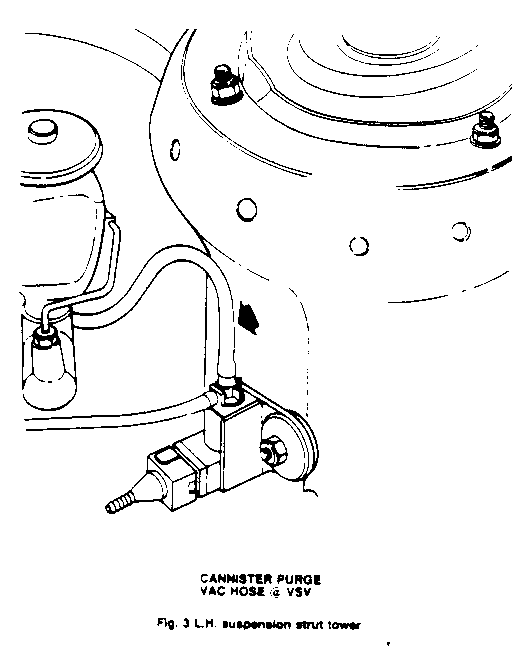HESITATION AND SAG ON LIGHT ACCELERATION

VEHICLES AFFECTED: 1985-87 'S' CARS
Some 1985-87 'S' cars may exhibit hesitation and sag on light acceleration. These conditions may exist at different engine coolant temperatures; therefore some customers may identify the subject condition as occurring at cold and/or warm engine conditions.
Since the repair procedure is different for a cold engine driveability condition than for a warm engine condition, it is important to identify the condition under which the customer is experiencing the engine hesitation and/or sag.
If the condition occurs mostly within the first two (2) miles of driving after an extended park period, such as overnight, then this can be considered a 'cold engine' condition.
If the condition occurs at all times (continuing after the initial 2 miles) then it should be considered as a 'warm engine' driveability condition.
The repair actions for the two driveability conditions described above are as follows: . 'Cold Engine' Driveability .
Set to specifications: Accelerator pump travel, engine idle speed, throttle positioner setting, timing, A/C idle-up speed and throttle position switch setting.
The procedures for these settings are detailed below:
1. Set to specifications accelerator pump travel - engine not running
(A) Remove air cleaner assembly.
(B) Ensure the choke valve is fully open.
. (C) Unscrew idle speed adjusting screw until throttle valve , is fully closed.
(D) Unscrew throttle positioner screw (Tp screw) until it is fully disengaged (See Illustration #1).
(E) Measure accelerator pump stroke and adjust by bending rod if necessary per specifications below:
1985 Model Year: 4r= (.158 inches) 1986 Model Year: 2mm (.079 inches)
(F) Reinstall air cleaner assembly.
2. Engine idle speed.
With engine warmed up to normal operating temperature, all electrical loads switched off and engine running, except where indicated, make adjustments in the following order.
3. Engine Timing.
Following appropriate underhood label instructions set timing to no more than 7 degrees B.T.D.C.
4. Throttle positioner setting - reference section 6El4-24 for the relavent model year in the Nova Shop Manual.
5. Air Condition idle up setting.
Where applicable adjust air conditioning idle up setting screw (See Figure #2) to 950 plus or minus 50 RPM with air conditioner compressor running, engine cooling fan not running.
6. Throttle Position Switch (TPS) setting (1986/1987 only).
(A) Disconnect plug canister purge vacuum hose at the vacuum switching valve (VSV) located on the left front strut tower underhood (See Figure #3) and plug VSV outlet.
(B) Disconnect vacuum hose from the 'M' port of the thermosatic vacuum switching valve (TVSV) and plug emo port.
(C) Disconnect green electrical connector (TP switch) located on the upper dash panel at the right hand side underhood. (See Figure #4)
(D) Connect tachometer.
(E) Connect OHM meter between "TPS" connector terminal (to carburetor) and ground.
(F) With Engine running at idle, slowly increase idle speed by open throttle to 1600 RPM. OHM meter should register open circuit. If OHM meter should show a closed circuit (continuity) adjust "TP" switch adjusting screw to give an open circuit (See Figure #1).
(G) Continue to increase engine speed to 2000 RPM . OHM meter should now register a closed circuit (continuity). If open circuit is shown adjust "TPS" setting screw to obtain a closed circuit.
(H) Increase engine idle speed to 2500 RPM and release to return engine speed to base idle.
(I) Repeat steps "F" thru "H" to check settings. Make further adjustments if necessary until switch is adjusted to ensure that the "TPS" switch closes between 1600 and 2000 RPM.
'Warm Engine' driveability - VIN serial number before GZ181026.
Follow the setting procedures described in the previous section WITH THE EXCEPTION of the timing setting specification. Timing must be set at NO MORE THAN 5 degrees B.T.D.C. to improve warm engine driveability.
Install the restrictor, part of jet kit-EGR, P/N 94844551 (1985 Fed. Spec.) 94844552 (1986 Fed. Spec.) and 94844553 (1986 Calif. Spec.) available from GMSPO, in the vacuum line from the EGR vacuum modulator 'R' port as shown on the accompanying vacuum hose routing label. To install the restrictor in the vacuum line, cut through the hose and insert the restrictor into each of the cut ends of the hose (See vacuum hose routing label in kit).
NOTICE: CARS SOLD IN CANADA HAVE CALIFORNIA EMISSION SYSTEM.
NOTICE: THE RESTRICTOR IS NOT DIRECTIONALLY SENSITIVE, IT CAN BE INSTALLED IN EITHER DIRECTION IN THE HOSE.
Apply emissions and vacuum hose routing labels (part of kit) in place of the original underhood labels,
NOTICE: THE KITS FOR CALIFORNIA EMISSIONS EQUIPPED CARS INCLUDE DIFFERENT VACUUM HOSE ROUTING LABELS FOR CARS WITH OR WITHOUT POWER STEERING. WHEN APPLYING THE HOSE ROUTING LABEL CARE SHOULD BE TAKEN TO ENSURE THAT THE LABEL APPROPRIATE TO THE VEHICLE IS USED.
'Warm Engine' driveability - VIN serial number GZ181026 and higher.
These vehicles incorporate a production 'Fix' for this condition. They have a new distributor with a revised advance curve as well as the restrictor described in the previous section.
Repair action for these vehicles is to follow the engine setting procedures detailed in the the 'Cold Engine' driveability section.
LABOR OPERATION NUMBER: USE CLOSEST APPLICABLE LABOUR OPERATION.
LABOR TIME: 1985 .6 HOURS 1986 and 1987 .9 HOURS AD-D WITH A/C .1 HOURS




General Motors bulletins are intended for use by professional technicians, not a "do-it-yourselfer". They are written to inform those technicians of conditions that may occur on some vehicles, or to provide information that could assist in the proper service of a vehicle. Properly trained technicians have the equipment, tools, safety instructions and know-how to do a job properly and safely. If a condition is described, do not assume that the bulletin applies to your vehicle, or that your vehicle will have that condition. See a General Motors dealer servicing your brand of General Motors vehicle for information on whether your vehicle may benefit from the information.
